 |
Charles Mitchell's bio is available.
Academic papers by Charles L. Mitchell are available. Notable programs in progress for Charles L. Mitchell are presented. Google Scholar |
OSLO

Oslo's location on the Oslo Fjord shapes this Norwegian city. As with other Scandinavian cities, in Oslo the ocean is always near. The Fjord makes Oslo an attractive city. Several downtown Oslo landmarks are highlighted by the Oslo Fjord. Oslo is not a large city, and one should not be surprised to find a relaxed atmosphere prevails. Norwegians are friendly which makes finding locations within Oslo uncomplicated. The Norwegian people help make this a thoroughly pleasant city to visit.
Norwegian is the closest language on the language tree to English. The similarities between Norwegian and English are great and can with some care be noticed and appreciated. One need not be concerned about speaking Norwegian, however, since almost everyone speaks English. Similarities between the U.S. and Norway are pleasing to discover.
For a city this size, there is much to do in Oslo. There are many places to go and much to see. The natural scenery in Oslo is perhaps the best of any European city. Norway's history is presented in several admirable museums. Oslo, also, has superlative parks, and the city has a superb reputation for sports.
Small shops and department stores make shopping in Oslo appealing. Norway is famous for sweaters, pewter goods, and silver. Various kinds of specialty shops help make an afternoon spent shopping in Oslo much amusement. Oslo's big department stores have an extraordinary selection of about everything one might want to purchase.
Because of the city's location at the end of the Oslo Fjord, Oslo has mild climate year round. Summer temperatures are not unusually hot, and winter temperatures are moderated by the Fjord. Oslo's outstanding climate makes this an agreeable, pensive city.
Oslo, A City Brought Together by Public Transportation
To encounter Oslo one must both walk and use the bus. While there are many pleasing attractions in downtown Oslo, some of the city's best places to visit are some distance from the center of town. Walking distances within the city center are not excessive. With the help of the bus and subway, places distant from downtown can be conveniently reached.
Being on foot in downtown Oslo is exhilarating. A pedestrian street lined with various businesses connects the train station and the area surrounding the Stortinget or parliament. There is a mall area several blocks long between the Stortinget and the National Theater. This mall has outdoor dining and is a focal point of downtown Oslo. The harbor is always nearby and fascinating to watch.
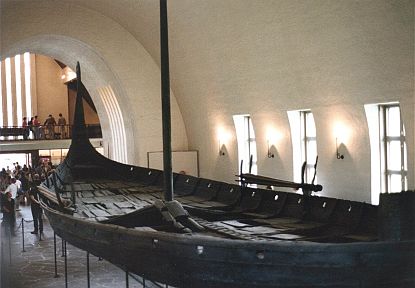
Public transportation in Oslo includes buses, street cars, a subway, and ferry boats on the Fjord. All of these means of transportation reach the outlying areas from the downtown. Buses and street car can be caught throughout the downtown. There is an underground station near the National Theater. Ferry service is available from the downtown piers to other areas of the city. Longer rides south on the Oslo Fjord are also possible from the downtown piers.
Discovering Norwegian History and the Outdoors
Begin the Oslo urban hike at the central train station. Follow the pedestrian street, Karl Johans Gate toward the center of Oslo. Four blocks up Karl Johans Gate turn right. Oslo Cathedral is one block ahead. A cathedral has stood on this location since the late 17th century. The exterior of the present cathedral was completed in the mid-19th century. The interior features several works of modern art.
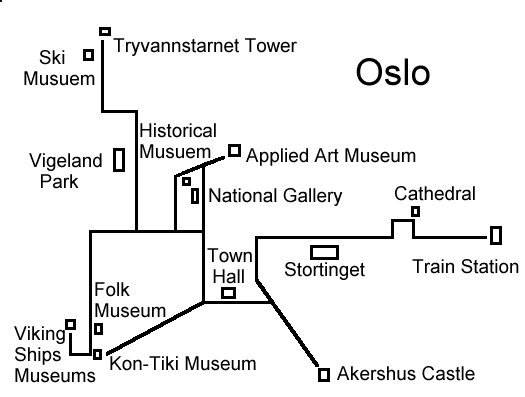
On the west side of the cathedral square is Glassmagasinet, one of Oslo's biggest department stores. Here one can obtain all kinds of Norwegian crafts, pewter, and silver as well as mundane goods of all kinds. Exceptional shopping is found along Karl Johans Gate and on the side streets on either side.
Next, return to Karl Johans Gate and continue toward the center of Oslo. Four blocks further on is the Stortinget, the Norwegian Parliament. Beyond the Stortinget, an especially pleasant mall with fountains and an open air restaurant extends for several blocks. The Norwegian Royal Palace can be seen from here several blocks further down Stortinget.
Turn left on Rosenkrantz Gate one block after the Stortinget. In three blocks, reach the Oslo Fjord. The Oslo City Hall is on the left and Akershus Fortress on the right. The downtown ferry piers are directly ahead.
Dating from 1300, Akershus is an enthralling medieval castle. The fortress overlooks the Oslo Fjord and provides some of the best views of Oslo harbor. The entrance to Akershus Fortress can be found by walking through the park surrounding the castle. Visit the interior of Akershus fortress. A guided tour conducted several times a day explains the history of Akershus.
A resistance museum detailing Norway's involvement in the Second World War is located in an old building in the fortress. The resistance museum presents the years from 1940 to 1945, as they happened in Norway. Commendable exhibits featuring documents, posters, recordings, and models make this museum worth visiting. After leaving Akershus Fortress, walk back toward the City Hall. Begun before the war in 1931, the City Hall was not completed until 1951. The building has been decorated with paintings and sculptures by Norway's most important artists. The City Hall has free guide service.
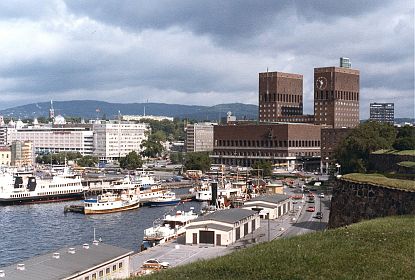
Leaving the City Hall, walk up Universitets Gate to a block past Karl Johans Gate. The National Gallery, Oslo's largest collection of Norwegian and foreign art, is located here. All periods of Norwegian art are well represented in this collection.
From the National Gallery continue up Universitets Gate to St. Olavs Plass and turn left on St. Olavs Gate. The Museum of Applied Art is a block further. The famous Baldishol Tapestry from the Middle Ages hangs here. Exhibits of contemporary Scandinavian design and continually changing special exhibits are also found here.
After the Museum of Applied Art, return to St. Olavs Plass and continue along St. Olavs Gate for three blocks to the Historical Museum. The Historical Museum is actually three museums in one. The Ethnographical Museum has exhibits from Africa, the Arctic, Oceania, and Indians of North and South America. The Numismatic Collection includes coins from all over the world from ancient time to the present. The Antiquities Collection has exhibitions from prehistoric Norway, the Stone Age, the Bronze Age, and the Iron Age, the Viking period, and the Middle Ages.
Following the Historical Museum, walk toward the Fjord on Frederiks Gate. The National Theater is a block and one half distant. From the National Theater catch a bus to the Bygdoy Area. There are three exceptional attractions here: a Viking Ships Museum, the Norwegian Folk Museum, and the Kon-Tiki Museum.
The Viking Ships Museum displays ships that have been found near the Oslo Fjord. There are three ships in all on display each about 1000 years old. One ships was owned by a Viking chief, and a second by a women. The third ship on display is less well preserved. Exhibits also include small boats, sleds, richly decorated carriages, implements, tools, harnesses, textiles, and kitchen utensils.
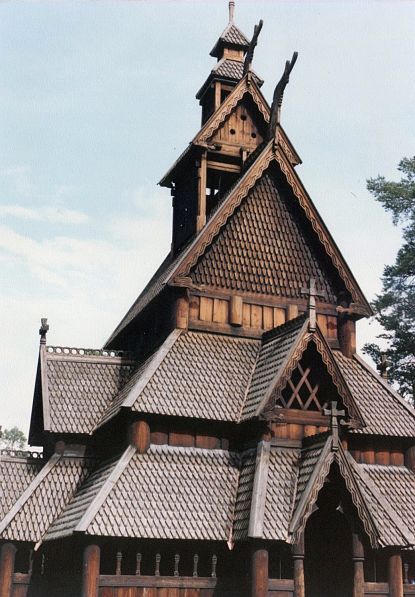
The Norwegian Folk Museum is located a short distance from the Viking Ships Museum. The Folk Museum is an open air museum with 170 building from all over Norway. A stave church from about 1200 is a highlight of the exhibition. Various types of farm buildings from the Middle Ages to present are on display. The Folk Museum, also, includes city milieus from the 18th and 19th century. The Kon-Tiki Museum houses the raft Thor Heyderdahl used to drift across the Pacific from Peru to Polynesia. Ra II, the 45 foot long reed boat, used for Heyderdahl's expedition across the Atlantic is also on displayed.
Catch a ferry from the Kon-Tiki museum back to the piers in front on the City Hall. From the downtown piers, walk to the tram stop near the National Theater and catch a tram to Vigeland Park. Gustav Vigeland's famous and once controversial nude statues are found in this park. 192 of Vigeland's sculptures are displayed in Vigeland Park. In all, there are 600 human figures in this unusual permanent outdoor exhibition. The monolith in the center of Vigeland Park is 50 feet high and depicts 121 entwined bodies. Vigeland Park itself is a large, well kept park including recreation facilities,a cafeteria, and restaurants.
After looking at Vigeland Park return on a tram to the National Theater. From the National Theater, take the Holmenkollenbaner or Holmenkollen Train from the underground station to the Holmenkollen stop, a ride of some 20minutes. Oslo's ski jump and ski museum are located here. Exhibits in the Ski Museum includes a 2500 year old ski and some of Nansen's and Amundsen's polar equipment. The top of the ski jump about 180 feet high can be reached by elevator for a peerless view of Oslo.
After visiting the ski museum and jump, return to the Holmenkollenbaner and continue on to the Volksenkollen stop. The Tryvannstarnet Tower is located a short walk from here. This tower provides a view of great distances in all directions and is the highest tower in North Europe.
The Tryvannstarnet Tower is the last attraction on the Oslo urban hike. Following a visit to Tryvannstarnet Tower, use the Holmenkollenbaner to return to the center of Oslo. This urban hike has begun introducing Oslo and should facilitate finding all of the city's important sights.
Appreciate Both Oslo and Norway
Oslo is, as other Scandinavian cities are, a very old city. Norway's past has been substantially shaped by this city at the end of the Oslo Fjord. Differences between Oslo and other Norwegian cities can make Oslo seem a strange place. The careful visitor; however, appreciates, Oslo is the product of centuries of peculiaristic development.
Imagine how Norway's geography has shaped Oslo. Norway is a country that has had population scattered along fjords remote from the capital. Until a generation or so ago, there were even significant differences in language among these scattered communities. Some of the same differences found along remote Fjords have also influenced Oslo.
Photographing Oslo enhances a visit to Oslo. The fjord adds to Oslo's photographic allure, and parks and outdoor museums are reliable subjects for a photographer. Downtown Oslo with its many attractions and bustle of people is, also, worthwhile to catch and film. The places in Oslo that have a superb view are better with a camera. Planning some shopping is another way to improve a visit to Oslo. The big department stores are appealing and one can find about anything in Oslo. Unusual bargains can sometimes be found in these smaller shops.
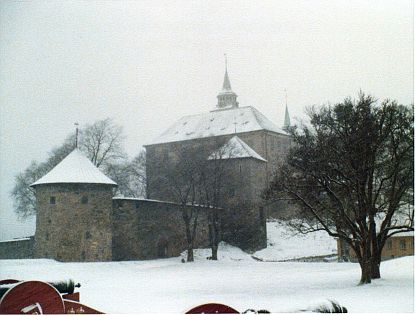
Oslo is one of Europe's most exhilarating cites. There is no city in Europe where the outdoors is so prominent. A day's activities in Oslo are nearly the same as a day outdoors in Norway. Located between mountains and the end of the Oslo Fjord, the city's natural landscape virtually dominates the urban environment.
To European Cities



